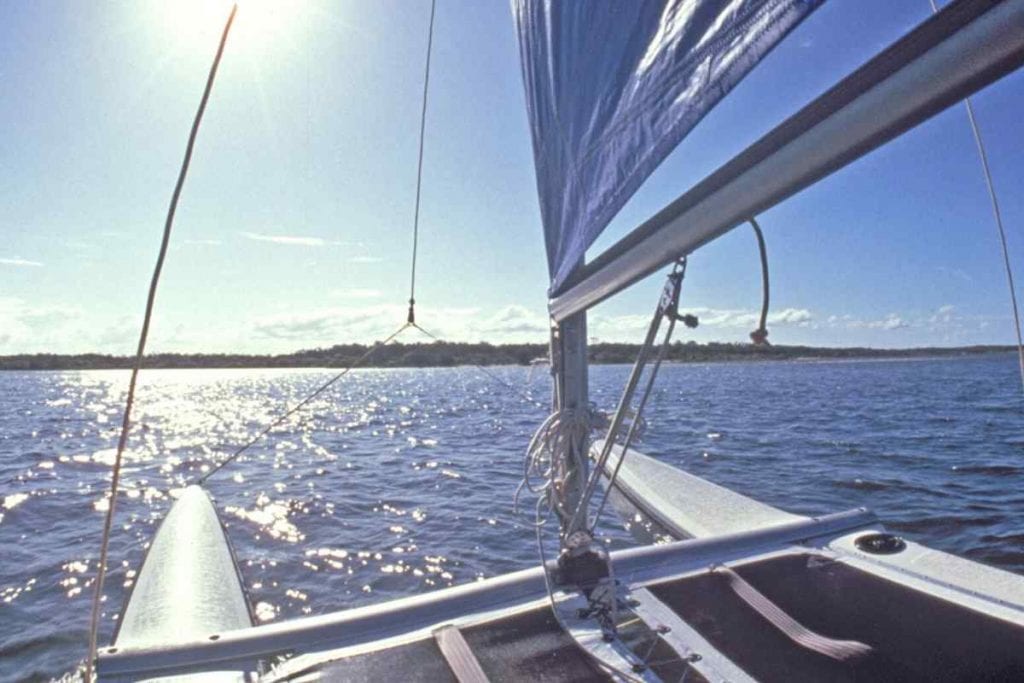Are Catamarans Stable in Rough Seas?
Whether you are looking to purchase a catamaran for your own sailing purposes, or are considering going on a catamaran adventure during your vacation, you may be wary of the boat’s ability to manage well in rough seas. Fortunately for you, the designers of the catamaran had this in mind as they created a boat that would effectively travel in any type of water.
Are Catamarans Stable in Rough Seas?
Are catamarans stable in rough seas? Yes, catamarans were designed with a twin-hull that creates the ideal structure for stability and power. The twin-hull provides a tunnel that traps the air between itself and the water, thus providing a layer of air to surround the boat and provide a smooth ride. Additionally, catamarans have a very stable platform as their beam to length ratio was designed 2:1.
There are many myths floating around that attempt to disprove the catamaran’s ability to navigate rough seas, particularly by their competitor the monohull. However, catamarans rank superior to the monohull in many ways and are considered to be a top-performing boat for rough seas as well as entertaining and hosting a pleasurable boat outing.
What Makes a Catamaran Stable?
As mentioned before, a catamaran is stable due to its overall design and ability to work with the natural elements to provide a pleasant ride. A catamaran was created with a twin-hull, trusted buoyancy, and an innovative beam to length ratio designed to provide stability and a smooth ride when navigated by the average sailor.
A twin-hull is exactly what it sounds like- it means that the boat has more than one hull. The hull is the main body of the ship. With a multi-hull or twin-hull design, the boat offers more of a smooth bottom than a rounded or pointed one (like a monohull) that would hit roughly against the water.
The twin-hull design also offers less drag which increases the efficiency of the boat. Since the engines are more spread apart, the boat is more easily able to be maneuvered, too. Most catamarans are designed to have twin (two) engines that can be used to the sailor’s advantage in navigating the boat.
Catamarans are created with a buoyant design. The twin-hull design means that the buoyancy is focused on the edges of the boat rather than its center, so it is more evenly spread and thus provides more stability.
So even in the unlikely event of the catamaran capsizing (which would require more than 70 knots of wind), the catamaran will not sink but will remain afloat. In this case, you would not have to worry about having something to keep you above water, though it is incredibly unlikely that this would happen in the first place.
Finally, the beam to length ratio is typically close to a 2:1 which provides stability onboard the boat as well. This means that you will be less likely to become seasick, tip over, or feel the overall effects of rough seas onboard the catamaran. For this reason, among others, catamaran rides are frequently enjoyed by varying demographics regardless of age or previous sailing background.
Are Catamarans More Stable than Monohulls?
Yes, catamarans are significantly more stable than monohulls due to their twin-hull design more evenly distributing the force of the rough waves slapping on the sides of the boat and the tunnel created to pad the boat with a layer of air surrounding it. Because of this, catamarans more typically offer a smooth ride than monohulls.
Catamarans also more typically offer a wider platform and living space, making for a comfortable and spacious luxury boat ride. The width of the catamaran adds to its stability as a feature that is often overlooked. As it is one of the most basic parts of the design (think physics), the width offers a greater scope of wave distribution for greater stability.
The stability of the boat will be one of the top-noticed factors for the enjoyment of the ride. Stability contributes to the experience of those on board the boat through their ability to feel the waves or not, be able to easily stand up without being knocked down, and often is the greatest contributor to becoming seasick or ill.
Additionally, the captain of the boat will notice the stability in the boat’s effectiveness and maneuverability in rougher waters. A catamaran is a great option for many reasons, but stability is one of the top features that this boat can offer an average or experienced boat enthusiast.

Are Catamarans Better for Seasickness?
Many people avoid boat rides altogether for fear of becoming ill on a boat. For good reason- nobody wants to become sick on a boat ride that is not expected to end soon, and nobody likes to experience common symptoms of seasickness such as vomiting, sweating, dizziness, and feeling generally unwell.
Catamarans are a great boat for those who find themselves getting more easily seasick than others. Due to the stability that catamarans provide, most people will be able to enjoy the waves of the water rather than being tossed by them. There are several factors that contribute to the catamaran being better for seasickness than many other boats.
Catamarans offer a twin-hull design- proven to provide stability, efficiency, and easy maneuverability. Catamarans also offer a more spacious area in their cabins, too, which means that there will be more angles in which a person can experience the ride. If you find yourself more prone to seasickness while standing, then there should be room for a bench, bed, or chair. If you find yourself more prone to seasickness while sitting on the other hand, then there should be plenty of room to walk around and see the sea.
For these reasons among many others, catamarans can offer a pleasurable boating experience for most people- even those who are more prone to seasickness. So, if you and your sweetheart are determining if you should or should not attend the catamaran sunset tour on your honeymoon, you do not have to worry even if one of you is more wary of becoming ill.
You can always take medication to prevent dizziness and other seasick symptoms if you are seriously concerned. But, of all of the boats to board, a twin-hulled catamaran is a great choice for those who are worried about getting seasick on the water.
Bonus Tip: In all my years of being on the water offshore fishing, hands down Bonine is the single best medicine for sea sickness. Take one the night before you go to bed. Then take another one when you wake up before heading out on the boat. You should be good to go then. PS- Don’t buy the generic. It isn’t as good. Use the real thing.
What is the Advantage of a Catamaran in Rough Seas?
Catamarans are so superior in rough seas that this feature is one of the boat’s most marketed details. Catamarans offer many advantages in rough seas that are expected to be navigated by an average or experienced sailor.
The most obvious advantage of a catamaran in rough seas is its twin-hull design providing stability and ease of maneuvering it. This creates an ideal setup for the sailor to be able to get the ship to go in any direction he or she pleases- providing safety for all passengers aboard the ship. Additionally, this provides the ability for the ship itself to avoid capsizing and remain balanced when the waves are crashing and abundant in rougher waters.
Another advantage a catamaran has in rough seas is that learning to sail a catamaran is actually found to be easier by many sailors than learning to sail other boats. As a sailor is more comfortable with his or her boat, he or she will be more easily able to navigate it in steady or rough waters. Particularly, the catamaran has been found to be an easier boat for new sailors to grasp the hang of in their first times in rough waters.
Catamarans also have the advantage of having a lower draft which means that a catamaran can be anchored closer to the shoreline. While this factor is not as telling about the catamaran’s stability in rough waters while out on the open sea, the ability to “park” it closer to the shore means that it will be less likely to feel the effects of a higher/rougher tide should this occur. Thus, your catamaran will be safer and more conveniently accessed should you decide to leave it there overnight.
The twin engines that often accompany the twin-hull design of a catamaran also offer increased maneuverability compared to a monohull/singular engine design. While it might not make sense at first to have more than one engine, the dual engine actually gives the sailor more power and ability to navigate the boat. The sailor can use the opposing forces of the engines to get the boat to travel more precisely than using a single-engine.
While monohulls have their advantages, too, the twin-hull of a catamaran simply cannot be beaten in this capacity. The stability that a twin or multi-hull design offers far outranks a monohull which is why the twin-hull is more consistently chosen for this purpose.
A catamaran is stable in rough waters, effective in steady/calm waters, and has the ability to pick up speed comparably to a monohull. The only question left to ask, is why are you not currently boarding a catamaran?
